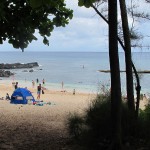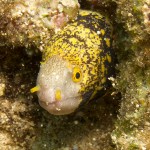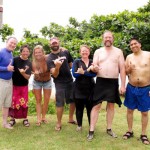With the south shores of Oahu denied us by rough conditions, we spent a day diving the north shore of the island. The specified rendezvous was a site known to local divers as Three Tables for a little shore diving. With an iPhone and Google Maps in hand, Deb and I drove across the island along unfamiliar roads to Oahu’s famous North Shore.

There were quite a few divers already present, including a class just getting their certification. Our group just added to the party. Charles and Jeannie, who had been with us on the previous day’s aborted dive at the YO-257. Another visitor from Texas, Ray, joined us for the dive.
Leading the dive would be Gabe Scotti, the owner of Kaimana Divers. Christine would be his backup. While Gabe led off, Christine would play the caboose, riding herd on the group. It was a nice day to be diving, we chatted while setting up the gear. It was a relaxed, Hawaiian style morning.
The sand on the beach was unusually soft, feet sank deeply into the sand under the weight of heavy scuba gear. It was best to support each other as well slogged through the sand to the water. The sand extends only a short way into the water, the bottom becoming rock about 20ft from the waterline.
I had not expected to see limestone in Hawai’i, yet the rock formations on this beach were clearly not basalt. Throughout much of the islands you can find basalt, basalt and other forms of basalt everywhere you go, there is little else. At Three Tables the local rock is limestone. It is this rock that creates the fascinating caves and underwater terrain we explored while diving. The eponymous Tables themselves are limestone outcrops.
A quick bit of research shows that the limestone is part of the Waimanalo Limestone formation found around Oahu. The formation is the remnants of ancient reefs formed during periods of high sea levels 120-130 thousand years ago. At the time the reefs formed 8-12m higher than today along the coastline of the island.

The algae covered rock supported a different community of creatures as well. Flatworms seemed quite common, with both Fuchsia (Pseudoceros ferrugineus) and Divided (Pseudobiceros sp.cf. dimidiatus) spotted a number of times by our dive party. I saw several of the usual day active reef nudibranchs, Pustulose (Phyllidiella pustulosa) and Fried-Egg (Phyllidia varicosa), with two Spanish Dancer egg masses found. There was also a sea hare, an enormous specimen found in the open. While this was the first hare I had ever seen, I immediately knew what it was and took a series of photos.
Between dives was also time for lunch. Just down the street, a five minute walk from the beach is a Foodland supermarket. While Gabe watched the vehicles and gear we walked down and bought drinks, sandwiches and chips in the market deli. The result was a nice lunch eaten in the small park overlooking the dive site.
On the second dive we explored a bit further than on the first. A few turtles, more caves, and a little white tip shark in a crevice. I backed off at the shark, we see these guys all the time. Our Texas visitors were thrilled with the shark.
The only issue I had was the usual photographers problem of wanting to spend time with the photo opportunities we found, as usual I was was always scooting to catch up with the rest of the group. Even so, I did manage some decent shots, if nothing truly great. I look forward to diving our home reefs where I dive often and can really spend time on the photos.

Three Tables is a decent dive site, apparently a favorite of local divers. There were certainly enough divers using the site on the morning we were there. I expect it is frustrating that the site is only available a few months out of the year.
Some folks say the diving is horrible on Oahu, from what I have seen I would argue. There were some pretty good dives to done here. We will have to plan another trip someday. I think some more island hopping is in order.


I’ve heard that the major reason for the coral-cover difference is runoff / turbidity plus substrate. I don’t know why sandstone would be a poor substrate (I would think it would provide enough cracks and sheltered areas for new colonies to get started), but maybe it erodes too quickly or is not strong enough to support the weight / water resistance of a more mature colony.